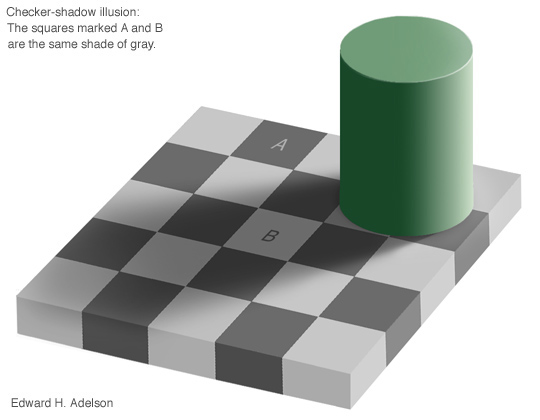你是否相信这两个区域的颜色完全一样呢...
也许不相信吧...不过答案是完全一样...
这两个区域的实际颜色完全一样
不相信的可以看下面的图
我把A和B单独拿出来了....


看到了吧...颜色完全一样....
如果还不相信...自己可以保存下来...然后用PS去自己试
或者也是最简单的
直接看它们颜色的RGB值(我已经对比了...都是107,107,107)
想知道原因,看下面的解释
The visual system needs to determine the color of objects in the world. In this case the problem is to determine the gray shade of the checks on the floor. Just measuring the light coming from a surface (the luminance) is not enough: a cast shadow will dim a surface, so that a white surface in shadow may be reflecting less light than a black surface in full light. The visual system uses several tricks to determine where the shadows are and how to compensate for them, in order to determine the shade of gray "paint" that belongs to the surface.
The first trick i*ased on local contrast. In shadow or not, a check that is lighter than its neighboring checks is probably lighter than average, and vice versa. In the figure, the light check in shadow is surrounded by darker checks. Thus, even though the check is physically dark, it is light when compared to its neighbors. The dark checks outside the shadow, conversely, are surrounded by lighter checks, so they look dark by comparison.
A second trick i*ased on the fact that shadows often have soft edges, while paint boundaries (like the checks) often have sharp edges. The visual system tends to ignore gradual changes in light level, so that it can determine the color of the surfaces without being misled by shadows. In this figure, the shadow looks like a shadow, both because it is fuzzy and because the shadow casting object is vi*le.
The "paintness" of the checks is aided by the form of the "X-junctions" formed by 4 abutting checks. This type of junction is usually a signal that all the edges should be interpreted as changes in surface color rather than in terms of shadows or lighting.
As with many so-called illusions, this effect really demonstrates the success rather than the failure of the visual system. The visual system is not very good at being a physical light meter, but that is not its purpose. The important task is to break the image information down into meaningful components, and thereby perceive the nature of the objects in view
翻译:
视觉系统的任务是辨别物体的颜色。而本例则显示了其辨别地板上色块的灰度的问题。只测量表面反射光线(亮度)是不够的:投影会使表面变得暗淡,从而使得阴影中的白色表面反射的光线少于完全光照下的黑色表面。视觉系统用几个把戏来试图辨别阴影的位置并对其进行视觉补偿。
1、如果一个色块比其周围的色块都要亮,那么它的亮度肯定就要高于它们的平均水平。本图中,处于阴影中的亮色块被暗色块包围,这样,即使它本身的颜色是暗的,它也应该比它周围的色块亮。相反,阴影外的暗色块被比它亮的色块包围,因而显得较暗。
2、阴影的边缘通常是柔和的,视觉系统总是试图忽略亮度上的渐变,以便分辨表面的颜色而不被阴影所误导,本图中的阴影之所以看上去像阴影,就是因为它是模糊的,而且造成阴影的圆柱也很明显。
本色块图由4个相邻色块构成的X型边界拼合而成,这种结合方式通常意味着每条边将被看作物体表面在颜色上的改变而不是阴影或亮度的不同。
上述的种种错觉产生的效果实际上证明了视觉系统的优点而非缺陷。它对测量物理实际的亮度确实力不从心,但这并不是它的目标。它的重要任务是把接收的图像信息转换成有意义的单独的部件,从而感知自然界的种种物体。
-------------------------------------------------偶是分隔线----------------------------------------------------------------
看来眼睛看到的也不一定是真的
中国的古语眼见为实...至少在这里说不通....
没了...纯属娱乐


没有评论:
发表评论